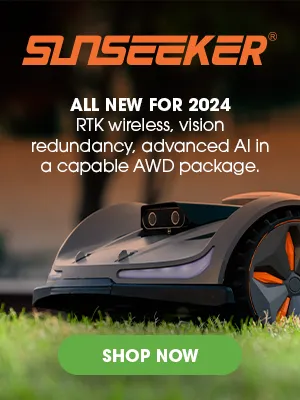Robotic lawn mowers have been around for several decades at this point, and have been evolving to become even more advanced over time. With the introduction of GPS navigation and virtual boundary wires, these robotic mowers are becoming increasingly sophisticated.
In this blog post, we’ll take a look at the progress being made on virtual boundary wires in robotic mowers and what we have to look forward to for lawn care options. So continue reading to learn everything there is to know about this innovative technology.
How Satellite Navigation Is Revolutionizing ROBOTIC Lawn Mowing
Currently, the vast majority of residential robotic lawn mowers are wired, meaning they require a physical boundary wire to be installed around the perimeter of the property.
But released in the U.K. last year are the newest lines of robotic lawn mowers that run off of virtual boundaries using satellite navigation.
Virtual boundary wires work by sending out a signal that is picked up by the mower. When the mower crosses the signal, it will turn around and go back the way it came. This makes sure that the mower stays within the limits you’ve established, giving you full control of where your lawn mower is.
If you have a large lawn, the initial setup of boundary wires can be quite an undertaking. With virtual boundary wires, you can set up your boundaries quickly and easily, without having to worry about physically installing anything.
Now, there are a few companies like Husqvarna working on bringing this technology to residential robotic mowers, offering a great addition for anyone who wants to have even more control over their robotic mower.
Related read: Robotic Mower Tech Breakthroughs We Saw in 2022
Why You Should Start Your Lawn Care Journey With a Husqvarna
Innovation has always been a cornerstone of the Husqvarna brand. In the lawn mowing category specifically, Husqvarna has a long history of introducing groundbreaking products and technologies that have helped make lawn care easier and more efficient for consumers.
This tradition began more than 25 years ago when Husqvarna launched the world’s first robotic lawn mower. This game-changing product not only automated the tedious and time-consuming task of mowing the lawn, but also did so with precision and without any supervision required.
Since then, Husqvarna has continued to innovate in the robotic lawn mower space, most recently with their EPOS (Exact Positioning Operating System) technology. EPOS is a GPS-enabled system that ensures your robotic lawn mower covers every square inch of your yard and can take on slopes with up to 50% inclination, resulting in a perfectly manicured lawn with minimal effort on your part.
If you’re looking for a reliable, effective, and low-maintenance solution for your lawn care needs, Husqvarna offers plenty of options. And keep an eye out for the upcoming U.S. version of the Husqvarna Automower® NERA. This top-of-the-line robotic mower will be a wireless 450 using EPOS technology for precision and without boundary wires! This is a high-end product that will make mowing your lawn easier than ever.
Related read: How much do robotic lawn mowers cost in 2023?
What Are Virtual Boundary Wires and Why Should You be excited?
Originally designed for commercial use, the concept of using virtual boundary wires for home lawns is a relatively new concept. We’re still not sure when this technology is coming to the states, but when it does, the number of people using robotic lawn mowers will likely dramatically increase.
Virtual boundary wires are one of the most powerful features of robotic mowers. They allow the mower to operate without having to be tethered to a physical wire, which is buried underground. Virtual boundary wires have many benefits, including:
1. Increased flexibility: Virtual boundary wires give you the ability to change the shape of your lawn without having to alter the position of the wire physically. This is especially beneficial if you want to change the design of your landscaping.
2. Easy installation: Unlike physical boundary wires, virtual boundary wires can be installed electronically. All you need is a power source and an Internet connection.
3. Reduced maintenance: Virtual boundary wires don’t require any special maintenance or upkeep.
Related read: How Virtual Boundaries Work on the Husqvarna CEORA EPOS
How Robotic Mowers Are Transforming the Industry
The future of robotic mowers is looking very promising. There are many companies working on developing virtual boundary wires for residential robotic mowers.
This technology would allow homeowners to set up a virtual fence around their property, and the mower would then stay within the boundaries.
Virtual boundary wires are still in the development stages, but there are already a few products on the market that use this technology for commercial lawn care. It is only a matter of time before this technology becomes mainstream and is used by most personal robotic mowers.
Overall, with the combination of virtual boundary wires, sensors and intelligent algorithms, robotic mowers are becoming smarter and more efficient than ever before. They will continue to provide homeowners with a beautiful lawn without having to spend hours manually trimming and edging it themselves.
Wrapping It Up
With the development of virtual boundary wires, residential robotic mowers are becoming a more viable option for homeowners. The technology is making it easier to keep lawns trimmed and free of weeds, while also reducing emissions in neighborhoods.
But the bottom line is we still don’t know when this technology is coming to homes in the U.S., just that it is on the horizon.
In the future, we can expect to see this innovative technology rolled out on a wider scale, allowing even more people access to convenient automated lawn care services. The potential advantages are clear: time-saving, cost savings and fewer environmental impacts from traditional gas-powered lawn mowers.





